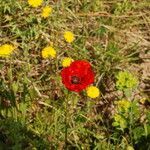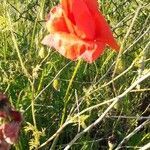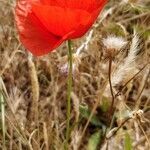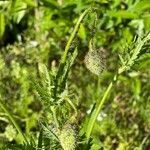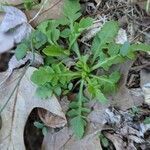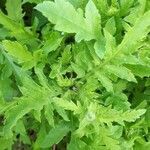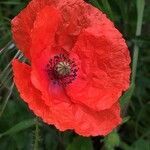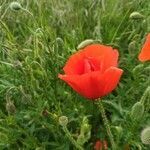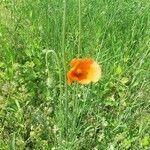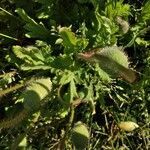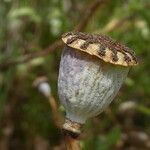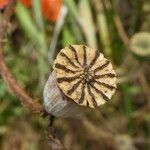Annual herb; rosette tufted; stems erect, usually sparsely hispid, 30-60-(100) cm tall. Lvs dull green, 7-20 × 1-8 cm, at least the lower petiolate. Lamina narrow-ovate to triangular, cuneate at base, sparsely to densely hispid, pinnatifid to 2-pinnatisect, the upper becoming less divided. Pedicels to 30 cm long, with fine spreading hairs throughout. Sepals hispid, 10-20 × 5-10 mm. Petals red, rarely pink or white, 2-4 × 2.5-6 cm, usually with dark, sometimes white, basal blotch. Capsule subglobose to broadly obovoid, widest above 1/2 way, flat-topped, rounded at shortly stipitate base, slightly ribbed, glabrous, 10-15-(20) × 8-15 mm. Stigmatic disc = width of capsule, flat when ripe; rays (5)-8-12-(18).
Plant annual, caulescent, sometimes subscapose, to 0.8 m high, hispid to setulose, without prickles. Stems simple or usually branching. Leaves to 15 cm long; upper leaves often somewhat clustered, not stem-clasping; lamina pinnately or bipinnately lobed; lobes not prickle-tipped. Peduncle sparsely to densely spreading-or ascending-hispid throughout. Petals to 35 mm long, white, pink, orange or red, often with dark basal spot. Stamens: filaments purple, filiform; anthers bluish. Ovary glabrous; stigmas 5–18; disc ± flat. Capsule sessile or substipitate, turbinate to subglobose, to 2 cm long, less than 2 times longer than wide, obscurely ribbed, glabrous.
Plants to 8 dm, hispid to setulose. Stems simple or usually branching. Leaves to 15 cm; distal often somewhat clustered. Inflorescences: peduncle sparsely to moderately spreading-hispid throughout. Flowers: petals white, pink, orange, or red, often with dark basal spot, to 3.5 cm; anthers bluish; stigmas 5-18, disc ± flat. Capsules sessile or substipitate, turbinate to subglobose, obscurely ribbed, to 2 cm, less than 2 times longer than broad.
Sparingly branched annual (biennial) to 1 m, ± hispid, the peduncles spreading-hispid throughout; lvs pinnately divided, the pinnae usually lobed or incised; buds 0.5–2 cm, pet 1.5–4 cm, variously red, purple, pink, white, or streaked, often with a basal dark spot; fr glabrous, ovoid to subglobose, 1–2 cm; stigmatic rays 8–15, typically 10; 2n=14. Native of Eurasia and N. Afr., widely escaped in our range, but seldom abundant. May–Sept.
An annual plant which grows up to 60 cm high. It is 15 cm across. The leaf shape and flower colour can vary. The leaves are soft and hairy and deeply divided. The leaves are 5-20 cm long. The leaves are green, not blue-green. The flowers occur singly in the axils of leaves. The flowers are 6-10 cm across. The flower petals have a dark spot at the base. The seed capsules are 0.8-1.5 cm wide. They are smooth.
Same as for P. aculeatum, with following distinguishing characters: Annual, occasionally perennial herb, 0.1-0.9 m high, forming robust cushions; glabrous or hairy, not bristly or spiny. Leaves amplexicaul, pinnately incised or pinnately compound, ± glabrous. Flowers solitary on elongated, bristly peduncles. Petals bright red, sometimes with black marks, drying magenta. Stamens brownish black.
